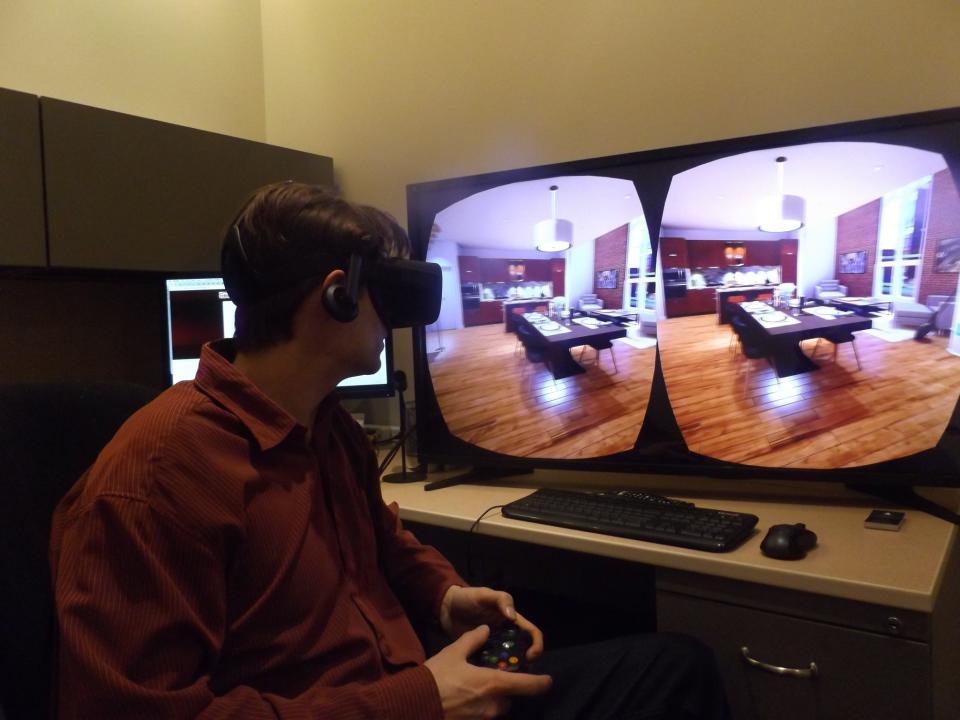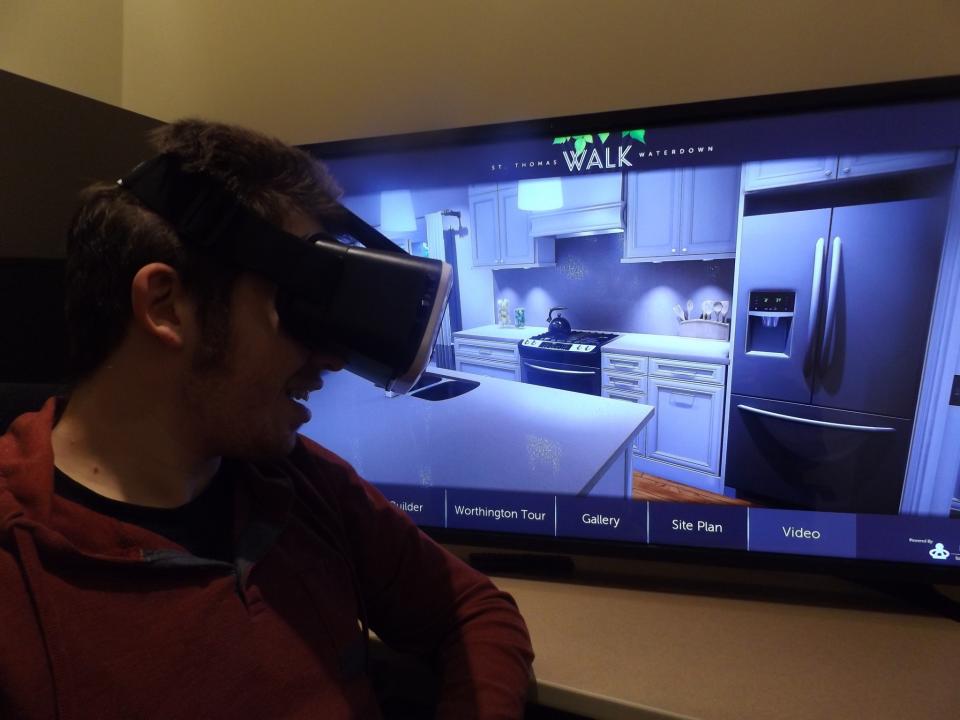How virtual reality is changing the real estate industry

With so many condos popping up in Toronto’s hot real estate market, more building developments are being sold pre-construction. But for homebuyers, buying pre-construction has always been a gamble.
Should I buy this floor plan or that one, prospective homebuyers wonder. What is the size actually like? Is this space going to be big enough for me? Is this going to be big enough for my family? Is my bed going to fit in the room? What kind of finishes do I need to go with?
In the past, all of these questions were undoubtedly on people’s minds, but buyers would just have to make educated decisions and hope it worked out. Thankfully, that isn’t the case anymore; it’s now possible to walk through your potential dream home and completely customize all the finishes just by looking at them, before builders even break ground on its foundation, thanks to virtual reality.
“When you use real-time virtual reality and you can literally walk around the common areas like the lobby and each unit of a condominium in a virtual representation of the space that’s dimensionally accurate to the millimetre,” says David Payne, CEO of Invent Dev Inc., a Toronto-based company creating virtual, interactive and 3D walkthroughs of spaces for real estate developers.
“What ends up happening is people feel comfortable, they know what they’re getting and they can make well-informed decisions, which makes for a better buying experience overall,” he says.
Virtual reality has become the new way realtors, builders and developers can provide that value-added service that differentiates them in Toronto’s highly competitive real estate marketplace. Virtual reality comes in many forms, however, and properly understanding how and when to use the various methods can make all the difference in their effectiveness.

Virtual Worlds in the Palm of Your Hand
As the broker of record for Toronto-based Spring Realty, Ara Mamourian has been incorporating basic mobile virtual reality in his resale listings since 2014. Every one of his listings has a mobile VR feature, which means prospective clients can take a virtual tour of every listed home on their phone through a series of stitched-together 360-degree photos of every room. For a slightly more immersive experience, the buyer can slide their phone into an inexpensive ($0-$40) viewfinder-style headset and every time they look one way, the photo or a fully-3D rendering of the room shifts that direction.
“There are a little less than 50,000 realtors on the Toronto Real Estate Board. Anything you can do to help stand out and present properties just a little bit better than that next guy is a no brainer. It doesn’t cost a lot of money to integrate just basic virtual reality into your business. It just takes a little bit of effort, there’s a learning curve, but then you just get it done,” says Mamourian.
Though Mamourian admits that mobile VR is more low budget than what people envision when thinking virtual reality — with full headsets like the Oculus Rift and the ability to walk through virtual rooms in real time — he says mobile VR is immersive enough for people to get the idea of how rooms are configured from all angles without actually visiting the property in-person.
“If you’ve got people from out of town who are trying to get a sense of what the place looks like from overseas, you can only get so much from a 2D floorplan. When you strap on a headset and get the full virtual reality experience, it gives you a sense of the volume of the space and you can actually see what it feels like to be in it,” says Mamourian.
Beyond the ‘WOW’ Factor
Nothing underscores the true strength of virtual reality like experiencing it in real time. Not only can you visit a home or condo developer’s showroom and literally walk through a home that isn’t there, while feeling the true depth of the space, but also there are so many benefits to VR for builders and real estate developers that go beyond the technological, immersive wow factor and the reduction of purchase anxiety for the customer.
“The upfront cost of the build itself is greatly reduced by not having to build a physical model. Plus, many companies want to go green and an easy way to make a statement for environmental preservation is by showing they are not building big, extravagant sales centres, only to tear them down at the end of the project. Instead, VR allows many developers to build smaller centres or rent out existing spaces or realty offices as a showroom,” says Payne.
Meanwhile, a fully-digital strategy using VR allows developers to launch the sales centre much faster because the builder isn’t waiting for permits to build it. These permits usually take months to obtain, but with VR, a developer could realistically sell out a property by the time they’d usually be ready to open the doors on a standard sales centre. Just like mobile VR, consumers also don’t even have to drive to the sales centre to experience the home — virtual reality can also be accessed online. But the biggest single benefit real-time VR before everything else is it’s fully customizable without a single after-market renovation.
“In some of the projects we’ve done, we’ve drastically increased the price per unit because we’ve included upgrade options, from structural changes like the ceiling height, layout and walk-in closets to built-in pantries, appliances, finishes and paint colour,” says Payne.
Through a VR headset, you can customize everything from a wall’s location to a backsplash just by staring at it for a few seconds. For example, Toronto developer Minto is launching a home development called Glen Agar in late spring 2017 where homebuyers can virtually walkthrough a preview of the development’s kitchen where they can instantly change finishes for countertops, cabinetry, backsplash and flooring. The information is relayed to the builders watching from behind a screen and they make sure the chosen option appears in the finished home.

Big in China
So if virtual reality costs less than a model home, speeds up the sales process and gets homebuyers to sign on the dotted line much more easily, why aren’t all North American real estate agents and developers using it?
“The adoption of VR within the real estate industry is low just because real estate is generally slower to adopt new technology in comparison to other industries like retail and telecommunications. There’s also a general thought that in an industry that’s hot, why should we bother innovating or improving?” says Payne.
Compare that to China, where Invent Dev worked with Vanke – the largest real estate developer in the world – and Payne observed that having a VR headset in your home there was as common as having a cell phone here. Chinese customers also have the ability to customize the floorplan of their homes while they’re living in it. It’s as simple as a contractor coming over for a day and sliding a few walls back. This option can be reflected in a virtual tour where you can experience the converted floorplan.
Chinese people don’t even go to sales centres, says Payne, preferring instead to stay home and tour homes virtually from their couch or in a mall. Most developers in China have done VR and homebuyers feel it’s extremely odd if there’s no VR setup as part of the marketing.
There are a few reasons for this, one is that traffic in China is so gridlocked that driving from one presentation centre to the other is basically impossible, but the other is that many developers and realtors in North America simply don’t understand virtual technology enough to know under what circumstances it’s most appropriate to use.
Virtual Reality Check
“A wrong way to use virtual reality is using it on the wrong target demographic. If it’s a development that’s targeting seniors using virtual reality generally won’t have the same impact as if it’s targeting millennials,” says Payne.
It also doesn’t make sense to use virtual reality if you’ve already built a physical representation of the space. If customers can already tour an actual location, then you don’t need a virtual one.
“If you are using virtual reality, it works best when it’s solving a specific issue. There are times when you need to evaluate the journey from going online to look at the home to actually making that purchase and understand what the objections are. Once you go through that exercise, it becomes more apparent where virtual reality can play a role. It’s more strategic, it’s not a canned solution,” says Payne.
For example, St. Leslieville Church Lofts called Invent Dev when they were struggling to sell condo units within a converted church in Leslieville. The sales centre was within the empty church building where the lofts would be. The church had extremely high vaulted ceilings and potential buyers just didn’t understand how the space would come together as a home. But as soon as Invent Dev came in and created a real-time virtual representation of the finished condo in the church that people could walk through, they sold 75 per cent of the development in two weeks.
“What’s great is we sold more units in one day than they had sold in an entire year, which goes to show VR had a tremendous impact,” says Payne.
Still, a full-service real-time virtual reality solution can be really expensive from set-up to take-down and execution, so real estate agents and smaller developers tend to only use it under specific circumstances.
“We’ve only incorporated that expensive stuff when we’re representing a developer and selling $100 million worth of condo apartments. With the price-per-square-foot we’re trying to achieve these days, it’s a lot easier to get someone to pay $900 a square foot if they can actually walk through a space virtually,” says Mamourian.
Invent Dev is trying to make real-time VR more attainable for realtors like Mamourian and smaller developers that typically can’t afford their services. Payne and his team are currently working on a software tool that allows users to design their own virtual floor plans in 3D and then have their clients explore it in real time using a headset.
“It’s a difference between a few hundred of dollars a month for the software versus tens of thousands for our full-package services,” says Payne.
With a solution like this, you may see real-time VR proliferate Toronto’s real estate market even more than it already has.
“As we see it, if we’re able to allow more people to experience real-time VR, so more people get that cozy comfortable feeling to remove anxiety about a custom home build or remove anxiety about a home renovation, this is something we want to do,” says Payne.

 Yahoo Finance
Yahoo Finance 
